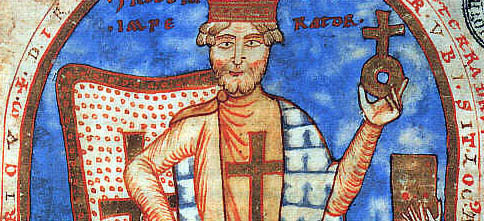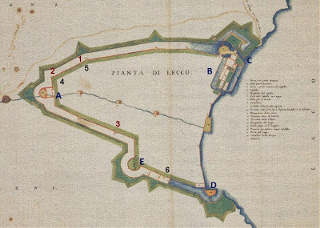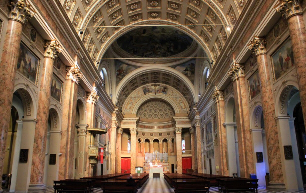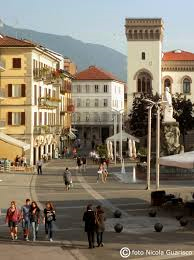Lecco's history
 That branch of the lake of Como, which extends towards the south, is enclosed by two unbroken chains of mountains, which, as they advance and recede, diversify its shores with numerous bays and inlets. Suddenly the lake contracts itself, and takes the course and form of a river, between a promontory on the right, and a wide open shore on the opposite side.
That branch of the lake of Como, which extends towards the south, is enclosed by two unbroken chains of mountains, which, as they advance and recede, diversify its shores with numerous bays and inlets. Suddenly the lake contracts itself, and takes the course and form of a river, between a promontory on the right, and a wide open shore on the opposite side. The bridge which there joins the two banks seems to render this transformation more sensible to the eye, and marks the point where the lake ends, and the Adda again begins - soon to resume the name of the lake, where the banks receding afresh, allow the water to extend and spread itself in new gulfs and bays.
From I Promessi Sposi (The Betrothed) by Alessandro Manzoni (1785 - 1873)
 Many legends exist about the complex historical events of Lecco town. Dating from the high-medieval period, it became a Carolingian county which controlled a large section of Lombardy and Emilia. Later it became a Commune and came under the influence of Milan, first for the feudal dues required by the Archbishop, then on account of the struggles between the Torriani of the Valsassina Valley and the Visconti. But in addition to the legends and stories, there are also concrete indications – such as the bridge of 11 arches over the Adda River, built by Azzone Visconti between 1336 and 1338 to consolidate dominion over the captured city and the surrounding countryside. But the town’s fame is attributable also to the literary reminiscences of The Betrothed, I Promessi Sposi, Alessandro Manzoni's literary masterpiece, which found in the mountains and shores of the lake the ideal setting for an immortal story. With the Industrial Revolution, Lecco became one of the most important industrial centres in Italy and the capital of a rich and industrious province. Thanks to its strategic location at the crossroads between an ancient piedmont route and the former transport routes of the lake and the river Adda, the area was always densely populated and boasts its own tradition of craftsmanship and commerce based on its ironworks. Many workshops survive along the Gerenzone torrent valley, creating an industrial archaeology"open air museum", which together with the big spinning rooms and silk factories – whether inactive or transformed – testify to the ancient tradition of silk making, concentrated primarily in the towns closest to the capital, such as Garlate, Malgrate, Valmadrera and Abbadia Lariana.
Many legends exist about the complex historical events of Lecco town. Dating from the high-medieval period, it became a Carolingian county which controlled a large section of Lombardy and Emilia. Later it became a Commune and came under the influence of Milan, first for the feudal dues required by the Archbishop, then on account of the struggles between the Torriani of the Valsassina Valley and the Visconti. But in addition to the legends and stories, there are also concrete indications – such as the bridge of 11 arches over the Adda River, built by Azzone Visconti between 1336 and 1338 to consolidate dominion over the captured city and the surrounding countryside. But the town’s fame is attributable also to the literary reminiscences of The Betrothed, I Promessi Sposi, Alessandro Manzoni's literary masterpiece, which found in the mountains and shores of the lake the ideal setting for an immortal story. With the Industrial Revolution, Lecco became one of the most important industrial centres in Italy and the capital of a rich and industrious province. Thanks to its strategic location at the crossroads between an ancient piedmont route and the former transport routes of the lake and the river Adda, the area was always densely populated and boasts its own tradition of craftsmanship and commerce based on its ironworks. Many workshops survive along the Gerenzone torrent valley, creating an industrial archaeology"open air museum", which together with the big spinning rooms and silk factories – whether inactive or transformed – testify to the ancient tradition of silk making, concentrated primarily in the towns closest to the capital, such as Garlate, Malgrate, Valmadrera and Abbadia Lariana.
 Pescarenico
PescarenicoPescarenico is a stopover that is worth a visit: it is a quaint quarter made up of small groups of fishermen's houses, the only one whose name is explicitly mentioned in The Betrothed. Even more concrete evidence of the presence of Manzoni in this locality is the Villa del Caleotto, the beautiful residence inhabited by the ancestors of the writer from 1615 onwards, which he sold in 1818.

The medieval walls
Lecco, veduta del campanileThe historic centre of Lecco retains the walls and the moat that surrounded the medieval town as well as a bridge built at the behest of Azzone Visconti in the 14th century which, although without its original towers, is still strongly imposive. The religious buildings are worth a visit: the basilica devoted to San Nicolò has a neoclassical plan resulting from its enlargement by the architect Giuseppe Bovara; it stands in an elevated position on the remains of the city walls which would have surrounded the town as early as the 13th century. The overhanging walls are still visible: they are connected to the 15th century circular tower on whose foundations the neo-Gothic tower was erected in 1882.
Nearby is the church of Santa Marta, with its baroque decorations. Under the Basilica is Piazza Cermenati, at the centre of which is the monument dedicated to the geologist and mountaineer Mario Cermenati from Lecco; at the juction corner with piazza XX Settembre the Palazzo delle Paure ("Palace of Fears"), a neo- Gothic reconstruction of the old customs house, stands on the ruins of the medieval town hall, where the coat of arms of the Visconti can be seen. The Torre Viscontea (Visconti Tower) overlooks the square, the only part of the fortifications of Visconti origin which survived intact the demolition decreed in the late 18th century; the Visconti Tower is now used as a museum and hosts temporary exhibitions.
Basilica San Nicolò
 The 18th century Basilica of San Nicolò rises on the northern border of the historical centre, on the ruins of the old walls of the town, This interesting building was redesigned and enlarged, by Giuseppe Bovara in 1830 and still today the remains of the ancient walls that join up with the circular turret mast and the Neo Gothic bell tower are visible. Inside you can find traces of the 12th century in the Baptistery chapel and late 13th century frescoes. nning of the village of Vergonzano, it has a big garden that goes down to lake and a corner tower decorated with arched-windows.
The 18th century Basilica of San Nicolò rises on the northern border of the historical centre, on the ruins of the old walls of the town, This interesting building was redesigned and enlarged, by Giuseppe Bovara in 1830 and still today the remains of the ancient walls that join up with the circular turret mast and the Neo Gothic bell tower are visible. Inside you can find traces of the 12th century in the Baptistery chapel and late 13th century frescoes. nning of the village of Vergonzano, it has a big garden that goes down to lake and a corner tower decorated with arched-windows.
Palazzo Belgiojoso
 Palazzo Belgiojoso is an example of the simplicity of the local art in the late 18th century, with the typical open courtyard with colonnaded porticos and hanging lodges. Once it belonged to Mellerio Belgiojoso and today it has become the Civic Archeological Museum and Natural Museum. There are important sections dedicated to the history and territory of Lecco, like the section relating to metallurgy.
Palazzo Belgiojoso is an example of the simplicity of the local art in the late 18th century, with the typical open courtyard with colonnaded porticos and hanging lodges. Once it belonged to Mellerio Belgiojoso and today it has become the Civic Archeological Museum and Natural Museum. There are important sections dedicated to the history and territory of Lecco, like the section relating to metallurgy.
 The Old Town
The Old Town
Lecco, vedutaWorth seeing, the central street of Via Cavour ends in the square dedicated to Garibaldi, where the Teatro Sociale designed by Bovara is located; also of interest is the church of Nostra Signora della Vittoria, located on the road that leads to the Azzone Visconti bridge. Of particular interest is also the church of San Giovanni Evangelista (St. John the Evangelist) with a beautiful Deposizione (Deposition) from the 16th century Cremonese school, and the church of San Giovanni Battista in the Laorca district, with a rich stucco decoration from the 17th century.